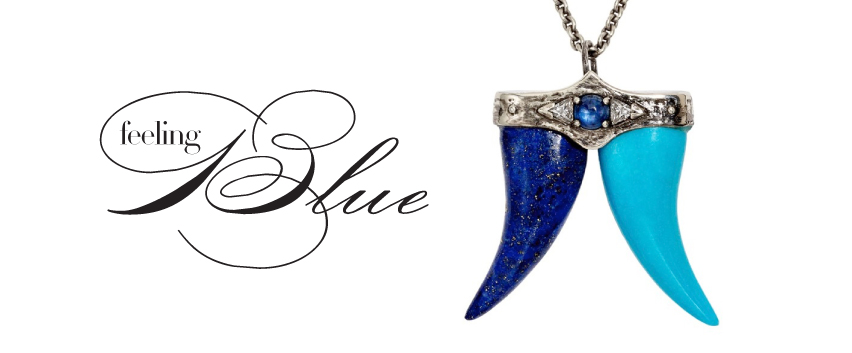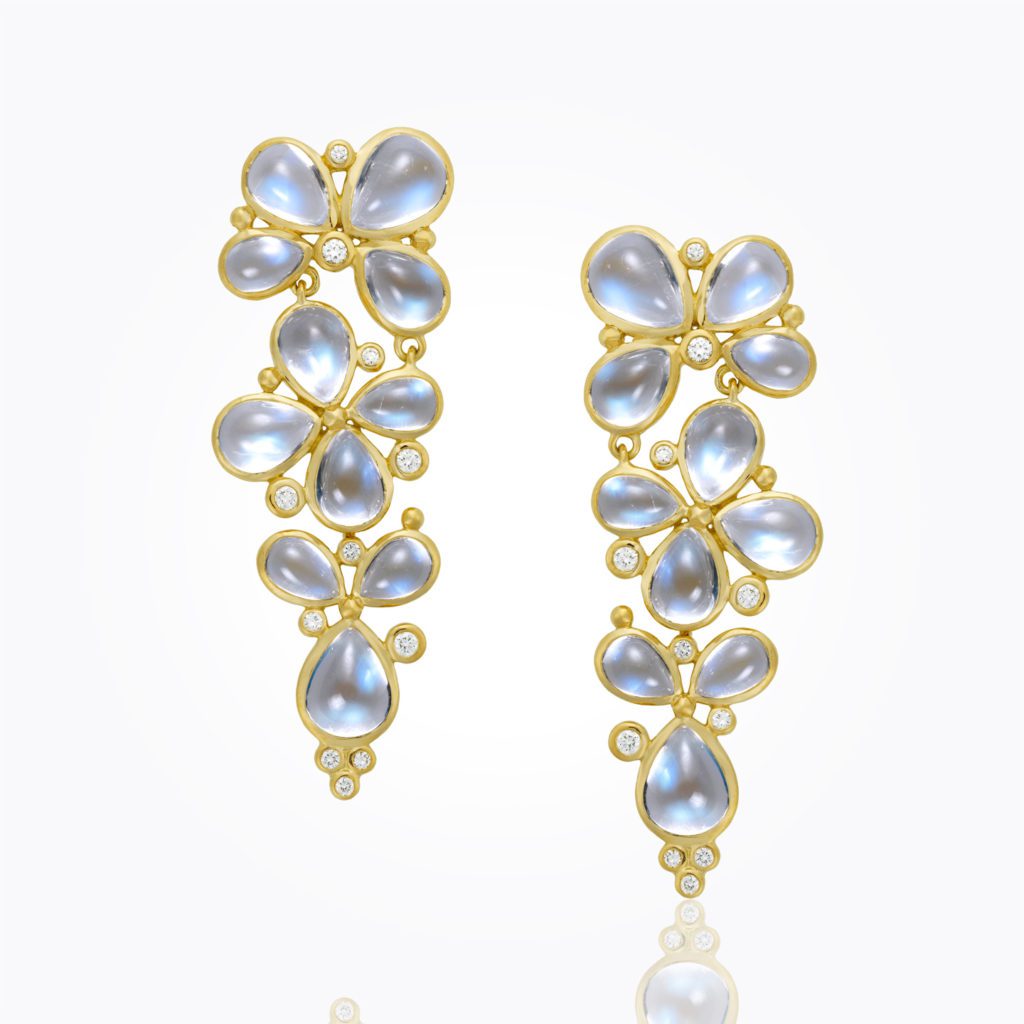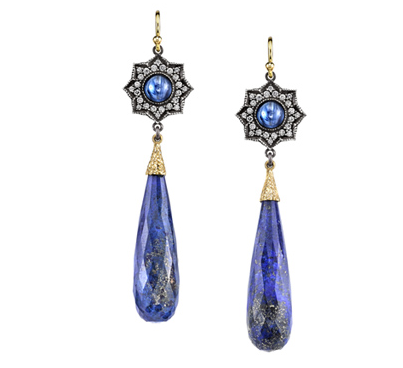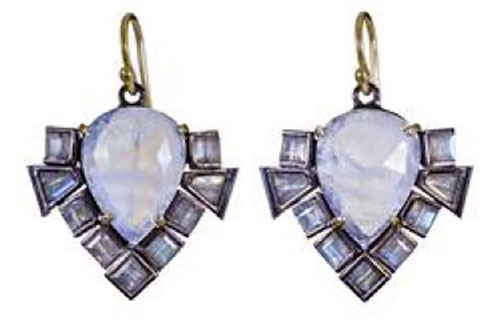From modern to antique: The Gemstones For All Seasons


Bell & Bird’s Victorian Era gold, diamond and lapis hinged bangle

Karen Karch’s double horn amulet in lapis and turquoise
For the past couple of years, the blues have set the mood for both modern and antique jewelry. Turquoise, lapis and blue moonstone have been in and out of style throughout history, but these stones have become staples of the contemporary women’s jewelry wardrobe and coveted gems in the antique enthusiast’s collection. From the happier sea blues of turquoise and the deep rich lapis twinkling with star-kissed flecks of pyrite, to the magically changing glow of the blue moonstone, these gems’ renewed popularity lends itself to the wear-now, wear-anywhere versatility of today’s lifestyle. The beauty and desirability of both period and contemporary pieces lies in the diversity of styles, symbolism and creativity.
- Andrea Fohrman’s gold, lapis and diamond crescent moon necklace
- Anthony Nak’s moonstone earrings
During the recent fashion runway shows, Lapis was named as one of Pantone’s colors for spring 2017, while turquoise has been accepted by designers and style-setting celebrities and consumers as a season-less gem no longer relegated to being pulled out after Memorial Day and put away before Labor Day.

Pamela Love’s lapis signet ring
A little of my own history with these gems: Before I began my career as a jewelry journalist, author and one-time jewelry designer, I had very mixed feelings about the three of them. Turquoise and lapis date back to ancient times and saw a major resurgence, along with moonstone, during the Victorian era. The next resurgence occurred when renowned houses such as Van Cleef & Arpels and David Webb created bold gold turquoise pieces with and without diamonds, sometimes in demi-suites, from the ‘50s through the late 60s.. But I didn’t become acquainted with these gems until I was in my pre-teen years in the early ‘70s.
My first associations with turquoise occurred when my newly divorced mom started wearing dangling Zuni turquoise earrings and cuffs and started dating a gorgeous French Canadian artist, who also wore turquoise in beads knotted with leather cording around his wrist. It was a time when this particular stone represented freedom, feminism, leftover hippies and moms who were finally putting aside Dr. Spock parenting to live out their own youth.
When I saw moonstones, they reminded me of mood rings changing colors — which were sort of magical when you weren’t in a teenage black mood. I loved the color of lapis, against the patina of oxidized silver, particularly in large ethnic style earrings until one got caught on a sweater and almost ripped my lobe.
I received my first turquoise and sterling silver ring when I was in fifth grade from my boyfriend. Three weeks later, after my finger broke out in a small rash and turned various shades of green, he broke my young heart when he changed his mind, took back the band, and gave it to one of my closest friends instead. Unfortunately I did not realize until much later that this is how long relationships last when you are a pre-teen.
The next time I wore turquoise, I was turning 30. My boyfriend, a humorous, barely-scraping-by writer, handed me a small box. At this point, I knew the relationship would not last. It wasn’t because I would have preferred an engagement ring, and it wasn’t because he re-gifted a band his college girlfriend had given him. It was because it was almost the exact same inlaid style that I received from the boy in fifth grade. Not only was I choosing similar guys, but they were giving me the same jewelry. Two years later, I dated a guy who said that my eyes were the color of turquoise and that he could see forever in them. Forever came a week later, when I found out he was seeing a woman with whom he worked and whose eyes were the same hue as … smoky quartz.
And so, when I started my career in jewelry, I learned that both turquoise and lapis were two of the earliest protective amulets from various cultures with meanings ranging from luck and good fortune to friendship and courage. It is believed that powdered lapis was used as eye shadow for Cleopatra. It was also ground into powder and made into ultramarine, the finest of all blue pigments. It was used by some of the most important artists of the Renaissance and Baroque periods.
- Past Era Victorian Turquoise Earrings
- Jennifer Meyer’s lapis and diamond earrings
- Bell & Bird’s antique turquoise and diamond locket
All of that knowledge helped dispel my mixed emotions about these historical gemstones.
Blue moonstone has become my favorite stone (along with ruby), and if you put one in your mouth during a full moon, it is supposed to help you foretell the future of your romantic life. It also brings good fortune and protection to travelers, so it has also become one of my travel talismans.

Temple St. Clair’s blue moonstone earrings
Yes – I believe all of this so keep reading…
I started to appreciate the beauty of lapis and turquoise against the buttery warmth of gold when I began collecting antique jewelry. Lapis is striking in Etruscan revival jewelry created in Victorian times. Turquoise in bombe, calibre cuts and set into sentimental forget-me-not flowers on rings and lockets also enjoyed popularity throughout the 19th century. Often, it was mixed with seed pearls or rose-cut diamonds and popped by the more fiery gemstones like ruby and garnet.

Doyle & Doyle lapis and gold Etruscan revival style necklace
Blue moonstones first came into vogue during the same period, yet continued to be gems of choice in the Art Nouveau and Edwardian/Belle Époque periods. I have collected a range of moonstone pieces representative of each of the periods.

Lang Antiques’ blue moonstone and diamond Victorian star brooch
Fast forward to the late 1990s and early 21st century, when designers like Cathy Waterman, Loree Rodkin, Erica Courtney, Karen Karch and other independent women designers took their cue from these earlier Victorian styles and created feminine jewels with turquoise, lapis and moonstone in high karat gold and modern diamond accents.

Karen Karch’s entwined turquoise heart
Soon after, designers like Gurhan, Lika Behar, and Arman Sarkisyan were showing turquoise and lapis in more ancient silhouettes and with high karat gold. Since then, almost every designer who works with gemstones has interpreted turquoise, lapis and the now extremely rare and expensive blue moonstone with their own distinctive aesthetic in cabochons, exclusive cuts and a range of looks, all set into yellow gold.

Arman Sarkisyan’s lapis gold, silver and sapphire earrings
Concurrently, Victorian through Art Deco styles in rings, earrings, lockets and brooches abound. These gems will always remind me that life is a series of experiences and when you glance back, they might make you smile and remind you of how you can change.
- Bell & Bird’s turquoise and rose diamond Victorian ring
- Bentley & Skinner’s Art Deco Lapis brooch
(Part of this article has been reprinted from my article in indesign.jewelry)











